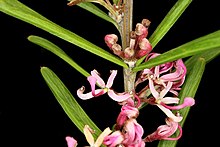Grevillea quinquenervis, also known as the five-nerved grevillea,[2] is a species of flowering plant in the family Proteaceae and is endemic to the western end of Kangaroo Island in South Australia. It is an erect, dense shrub with more or less linear to oblong or narrowly egg-shaped leaves and clusters of pale to deep pink flowers.
| Grevillea quinquenervis | |
|---|---|

| |
| Scientific classification | |
| Kingdom: | Plantae |
| Clade: | Tracheophytes |
| Clade: | Angiosperms |
| Clade: | Eudicots |
| Order: | Proteales |
| Family: | Proteaceae |
| Genus: | Grevillea |
| Species: | G. quinquenervis
|
| Binomial name | |
| Grevillea quinquenervis | |

Description
editGrevillea quinquenervis is an erect, dense shrub that typically grows to a height of 1.0–1.5 m (3 ft 3 in – 4 ft 11 in) high and has angular, hairy branchlets. Its leaves are more or less linear to oblong or narrowly egg-shaped with the narrower end towards the base, 15–60 mm (0.59–2.36 in) long and 1.5–8 mm (0.059–0.315 in) wide with the edges strongly curved downwards or rolled under. The upper surface of the leaves usually has 5 prominent, longitudinal veins. The flowers are arranged on the ends of branches or short side-branchlets in groups of 6 to 20 and are pale to deep pink, the pistil 9.5–12 mm (0.37–0.47 in) long. Flowering mainly occurs from October to December and the fruit is an oval to oblong follicle 13–15 mm (0.51–0.59 in) long.[2][3]
Taxonomy
editGrevillea quinquenervis was first formally described in 1909 by John McConnell Black in Transactions, proceedings and report, Royal Society of South Australia from specimens collected in 1908.[4] The specific epithet (quinquenervis) refers to the five-veined leaves.[5]
Distribution and habitat
editFive-nerved grevillea grows in heath, shrubland and forest on the western half of Kangaroo Island in South Australia.[2][3]
See also
editReferences
edit- ^ "Grevillea quinquenervis". Australian Plant Census. Retrieved 14 November 2022.
- ^ a b c "Grevillea quinquenervis". Australian Biological Resources Study, Department of Agriculture, Water and the Environment: Canberra. Retrieved 14 November 2022.
- ^ a b "Grevillea quinquenervis". State Herbarium of South Australia. Retrieved 14 November 2022.
- ^ "Grevillea quinquenervis". APNI. Retrieved 15 November 2022.
- ^ Wrigley, John W.; Fagg, Murray A. (1991). Banksias, waratahs & grevilleas : and all other plants in the Australian Proteaceae family. North Ryde, NSW, Australia: Angus & Robertson. p. 316. ISBN 0207172773.